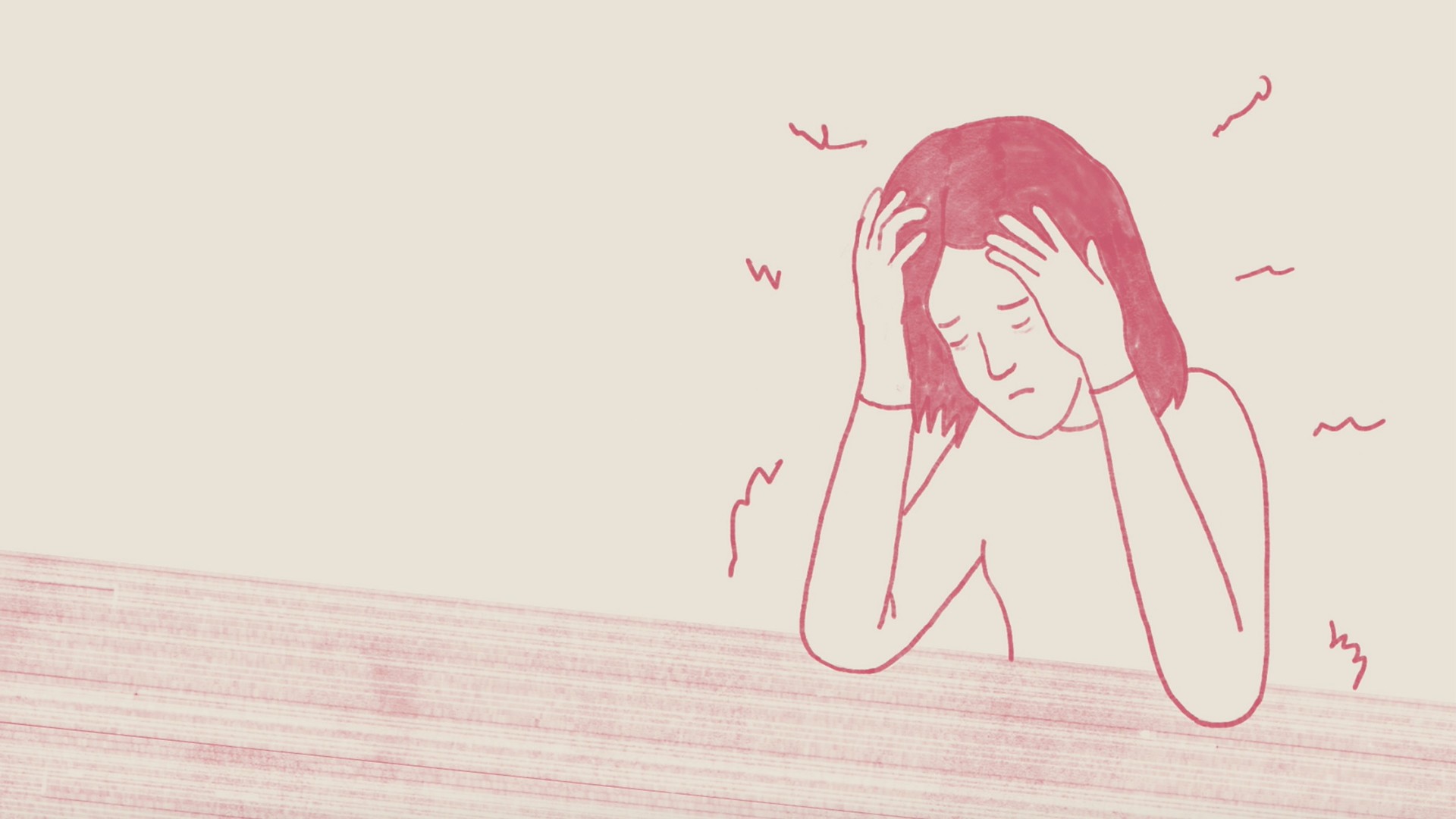Sharon Pruitt / Getty
One day recently, a friend told me how calming he found my presence to be.This was ironic because, on that particular day, I was in the midst of a weeks-long, slow-building hypochondriacal panic that involved a hastily scheduled visit to the doctor, an emergency session with my therapist, and a Google-Doc diary entry titled “Feeling Shittier and Shittier,” all while an unrelenting stream of negative thoughts played on a loop in my mind. Meditation apps were no match for this demon, and de-stress tea didn’t help much, either. I had returned for another visit to what the author Matt Haig calls “a private hell.”
As it turned out, like numerous previous hypochondriac episodes I’ve had—over fears that I have a heart condition; or that I’m losing my vision, my hearing, or my mind; or that I have an STD, or a hernia, or some kind of terminal cancer—this was a false alarm. But, in the middle of it, it didn’t feel false. (They never do.) And at the moment my friend remarked on my calmness, my brain was in flames.A few weeks later, after my anxiety had subsided, I came upon an article that explained—or at least corroborated—the chasm between my internal and external selves. “I am, as they say in the clinical literature, ‘high functioning’ for someone with an anxiety disorder or other mental illness,” Scott Stossel wrote in an Atlantic article on anxiety from 2014. “I’m usually quite good at hiding it…To some people, I may seem calm. But if you could peer beneath the surface, you would see that I’m like a duck—paddling, paddling, paddling.”My anxiety isn’t as extreme as Stossel’s, and I’d describe myself as more “frequently fearful” than full-on “phobic.” And yet I read that passage with a strong sense of recognition.As one of those ever-paddling anxiety-ducks, I’ve spent untold amounts of mental and emotional energy in my life trying to choose between two bad options. Do I fully express what I’m feeling inside, and come across as a jittery, nervous, sweating mess? Or do I play it cool and pretend that everything is okay, which, depending on the severity of the anxiety, can feel like I’m living a total lie?Anxiety disorders are remarkably common, currently affecting 40 million adults. The National Institute of Mental Health reports that, based on data from the early 2000s, 19.1 percent of Americans reported an anxiety disorder in the previous year, and nearly one in three American adults will experience an anxiety disorder in their lifetime. “One day, if everyone who struggled with anxiety decided to wear some piece of red clothing,” says John Forsyth, a professor of psychology at the University of Albany. “You’d be hard-pressed to go about your day without seeing somebody wearing red.”And yet stigma and misunderstanding about anxiety persist. Some people may think a person suffering from public speaking-, or flying-, or social-related panic is making a choice to feel that way. (They aren’t.) Others may hear the word “anxiety” and associate it with fleeting jitters before a job interview or a speech. But it’s much more than that. “Without firsthand experience, the impact this disorder has on a person’s life is difficult to understand,” says one anonymous anxious person on the National Alliance on Mental Illness website. “For us, the anxiety lingers every day. It is an excessive, unrelenting, emotionally unpredictable and a mentally crippling disorder centered on expecting the [worst] in every situation, even with the absence of reason.”Anxiety can be disabling and all-absorbing, says Jennifer Wild, a professor of experimental psychology at the University of Oxford. “And when you don’t know where it’s coming from and you don’t know how to make sense of it, it feels like it’s never going to change. That’s quite frightening. And it feels like you don’t have control of your mind or your body,” she adds. The urge to avoid this awful feeling can lead to all kinds of safety-seeking and avoidant behaviors, she explains, which can wind up transforming a person’s life into one steered by fears rather than their dreams.
More from Tonic:
I know what this feels like. My life has been marked by such safety-seeking behaviors, many of them embarrassing to admit. Because dancing makes me anxious, for reasons I haven’t fully figured out (although fear of looking awkward probably has something to do with it), I tend to avoid the dance floor at weddings. Because I’m pale and prone to sunburn, prolonged exposure to sun also makes me anxious, which makes things uncomfortable in all kinds of warm-weather situations. My full list of fears can feel endless: the countries I haven’t traveled for fear of what could happen there, recreational drugs I never tried for fear of permanent effects, the things I didn’t say for fear of how they’ll be received…the list goes on.And yet I haven’t escaped anxiety simply because I’ve tried to avoid it. In my experience, anxiety is a kind of ingenious, shape-shifting villain that knows the things I care about, and attacks them. Articles I’ve written, friendships, romantic relationships, family relationships, my body, my health, my future, my past—anxiety has, at one time or another, cast a shadow over each of these things.Recently, I was invited to speak at a journalism event in Brazil, which was both an incredible opportunity, and an anxiety extravaganza. Anxiety permeated nearly every aspect of the trip, including the night before my big panel, when I was too anxious to sleep, and then anxious about the fact that I couldn’t sleep and what that would mean for my speaking ability the following morning. I wound up doing fine, with about 45 minutes’ worth of sleep.Only recently did I start experimenting with being more open about what I so often feel. For most of my life, though, I’ve strained to hide these fears inside of a placid, unperturbed shell. It’s tiring.So what can an anxious person do about this dilemma?Well, to start, if they’re in a position to access therapy, I recommend it. The ADAA has a useful primer on therapy, and so does the National Institute of Mental Health. Therapy not only offers me a place to be totally unguarded and open about my fears (which is a visceral relief, for an inveterate anxiety-hider), but it’s also helped me understand the myriad ways anxiety affects my life, giving me new strategies for coping and prevention. Looking back, it’s mind-boggling to me how long I waited before making the call to schedule my first appointment.Therapists, not surprisingly, tend to have great ideas about confronting anxiety head-on. Debra Kissen, a therapist and clinical director of Chicago’s Light on Anxiety treatment center, told me about a public-speaking group she runs where participants “practice giving really bad presentations” so they can realize that the consequences of stuttering or saying “um” aren’t as bad as they fear. She described other kinds of exposure training, too, like walking into stores with clients for them to practice publicly falling down. The theme in all of this, she said, is that “it’s good to face one’s fear and realize, even if it’s hard, that you’re strong and you can handle life.”Another therapist I spoke to, Dennis Tirch, director of New York City’s Center for Compassion-Focused Therapy, helped me to understand just how natural and logical it is for people to feel anxious. “It doesn’t mean you’re broken. It’s not a feature of illness; it’s a feature of your humanity,” he tells me. Human beings have evolved with a hair-trigger, 24/7 threat-detection system, he says, and we live in a society that bombards us with more stimulation—from phones, TV, everyday life in large cities—than generations of our ancestors would have been exposed to in their lifetimes. “It’s going to cause us to have muscle tension or our stomachs are going to be distressed, and we’re going to generate all sort of fantasies about everything that could go wrong,” he tells me. But this “totally normal, it’s totally natural.” Remembering the sheer normality of anxiety is a strong weapon against the urge to hide it.There are limits of course, to how far you can take advice to express anxiety. I would never recommend turning to a stranger on a plane and saying, “This plane’s going to crash and we’re all gonna die,” even though I recall plenty of times when I was sure this was the case. (I would recommend giving yourself a creative writing exercise to complete, in-flight. Even something as simple as describing your own apartment can occupy your mind enough to distract you from your fears.) But the overwhelming consensus I got from experts was that fighting and/or hiding anxiety is a sure way to make it worse.University of Michigan psychiatry professor James Abelson is a member of the chorus of experts who tell me that fighting would make it worse. As an example, he describes a person who’s anxious before a presentation and briefly shares that fact with their audience, so they aren’t be wrestling on the inside the whole time, wondering whether they the crowd is noticing their nerves or not. “Anxiety is the most common type of emotional distress experienced by humans,” Abelson says. “And we are likely to respect the person who can own it and acknowledge it and plow through it.”In Abelson’s words, playing it cool isn’t the opposite of expressing anxiety; the two things can be combined. “You can’t be courageous without first being anxious or fearful,” he said. “Courage is what we display when we face our fears and anxieties and take the risks of tackling the challenge despite those feelings. So when you are open about it, you are being both cool and courageous.”Sign up for our newsletter to get the best of Tonic delivered to your inbox weekly.
Advertisement
Advertisement
More from Tonic:

I know what this feels like. My life has been marked by such safety-seeking behaviors, many of them embarrassing to admit. Because dancing makes me anxious, for reasons I haven’t fully figured out (although fear of looking awkward probably has something to do with it), I tend to avoid the dance floor at weddings. Because I’m pale and prone to sunburn, prolonged exposure to sun also makes me anxious, which makes things uncomfortable in all kinds of warm-weather situations. My full list of fears can feel endless: the countries I haven’t traveled for fear of what could happen there, recreational drugs I never tried for fear of permanent effects, the things I didn’t say for fear of how they’ll be received…the list goes on.
Advertisement
Advertisement
